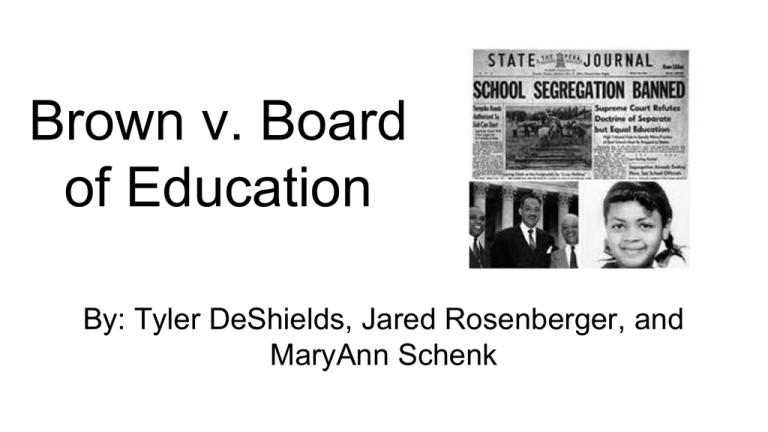Brown v. Board of Education
advertisement

Brown v. Board of Education By: Tyler DeShields, Jared Rosenberger, and MaryAnn Schenk Background on Brown v. Bd. of Education The case was in 1954 and is known as one of the greatest Supreme Court decision of the 20th century. The case set a standard for racial segregation of children in public schools. The Supreme Court stated that the Equal Protection Clause of the Fourteenth Amendment was violated in the case. *The Equal Protection Clause says it forbids states from denying any person of “Life, Liberty or Property, without due process of law” or to “deny to any person within jurisdiction the equal protection of the laws.” *Due process of the law states no individual can be deprived of life, liberty, or property without appropriate legal procedures and safeguards. Extra Background on The Case Brown v. Bd. of Education was not one case but many in different states such as Kansas, South Carolina, Virginia, and Delaware. Families of these states filed court cases against segregation in public schools. The main case of Brown v. Bd. of Education was in Topeka, Kansas as Oliver Brown filed a court case against the board of education at Topeka’s white schools. Brown’s claim the the schools with racial segregation were violating the constitution's equal protection clause because the cities black and white schools were not equal to each other and would never be. The Chief Justice Earl Warren made the decision unanimous and hand wrote the decision himself. What happened and who was involved... The case started 60 miles east of Topeka in the Kansas city suburb of Merriam Kansas, where a thirty year old jewish woman named Esther Brown noticed the horrible conditions of the school for the black students. The black students school was an eighty-eight year old two room school. while the white students were getting a brand new school built for them. What happened and who was involved continued... After Esther's efforts, the NAACP (National Association for the Advancement of Colored People) took over the case. The NAACP recruited black parents as plaintiffs to support them in the case. After everyone was on board with the plan, the complaint of the blacks school conditions was filed with the District Court of Kansas and trial was set for June 25, 1951. Robert Carter and his colleague Jack Greenberg were the attorneys for Brown and the NAACP. What happened and who was involved continued... The attorneys and witnesses gathered in hotel rooms paid for by Esther to discuss how they were going to win the trial. Carter had three very important people on his side that eventually won the case over for him. Those three were Hugh Speer, Horace English, and Louisa Holt. Those three people convinced the judges that the schools were separate, but not equal and how the black students felt inferior to the white students. On May 17, 1954 Brown had won the case. https://www.youtube.com/watch?v=TTGHLdr-iak Our Original Document Works Cited: “PBS.” PBS. PBS, n.d. Web. 4 Nov. 2015. <http://www.pbs.org/newshour/extra/2014/04/60th-anniversary-of-brown-v-board-ofeducation-resources/> “Brown v. Board Of Education, Document H: Segregation Laws Map (1953) - Bill of Rights Institute.” Bill of Rights Institute. N.p., 2013. Web. 4 Nov. 2015. <http://billofrightsinstitute.org/brown-v-board-of-education-document-h-segregation-laws-map-1953/> “DBQ - CCAWHCountryproject.” DBQ - CCAWHCountryproject. Web. 4 Nov. 2015. <https://sites.google.com/a/sduhsd.net/ccawhcountryproject/dbq> “Law At the End of the Day.” : "Elements of Law" Course 2.0: A Framework Course for the U.S. Law Curriculum. Web. 4 Nov. 2015. <http://lcbackerblog.blogspot.com/2011/07/elements-of-law-course-20-framework.html> Works Cited continued... "Brown v Board of Education of Topeka: An Account." Brown v Board of Education of Topeka: An Account. Web. 6 Nov. 2015. Brown V. Board of Education. Digital image. Conncriminaldefense.com. N.p., n.d. Web. 5 Nov. 2015. Women Protesting. Digital image. Pbs.org. N.p., n.d. Web. 5 Nov. 2015. <pbs.org>. Segragation Banned. Digital image. B-v-boe.weebly.com. N.p., n.d. Web. 5 Nov. 2015. <b-v-boe.weebly.com>.

